First published by Ashgate Publishing
Published 2016 by Routledge
2 Park Square, Milton Park, Abingdon, Oxon OX14 4RN
711 Third Avenue, New York, NY 10017, USA
Routledge is an imprint of the Taylor & Francis Group, an informa business
All rights reserved. No part of this book may be reprinted or reproduced or utilised in any form or by any electronic, mechanical, or other means, now known or hereafter invented, including photocopying and recording, or in any information storage or retrieval system, without permission in writing from the publishers.
Notice:
Product or corporate names may be trademarks or registered trademarks, and are used only for identification and explanation without intent to infringe.
Founded in 1846, the Hakluyt Society seeks to advance knowledge and education by the publication of scholarly editions of primary records of voyages, travels and other geographical material. In partnership with Ashgate, and using print-on-demand and e-book technology, the Society has made re-available all 290 volumes comprised in Series I and Series II of its publications in both print and digital editions. For information about the Hakluyt Society visit www.hakluyt.com .
ISBN-13: 978-1-4094-1393-6 (hbk)
Disclaimer
The publisher has made every effort to race copyright holders and welcomes correspondence from those they have been unable to contact.
WORKS ISSUED BY
The Hakluyt Society
STORM VAN S GRAVESANDE
VOL. I.
SECOND SERIES.
No. XXVI.
ISSUED FOR 1911.
COUNCIL
OF
THE HAKLUYT SOCIETY.
ALBERT GRAY, Esq., K.C., President.
THE RIGHT HON. THE LORD BELHAVEN AND STENTON, Vice-President.
SIR CLEMENTS ROBERT MARKHAM, K.C.B., F.R.S., Vice-President.
THE RIGHT HON. THE LORD PECKOVER OF WISBECH, Vice-President.
THOMAS B. BOWRING, Esq.
COLONEL CHARLES FREDERICK CLOSE, C.M.G., R.E.
BOLTON GLANVILL CORNEY, Esq., I.S.O.
MAJOR LEONARD DARWIN, late R.E., Pres. R.G.S.
WILLIAM FOSTER, Esq.
THE RIGHT HON. SIR GEORGE TAUBMAN GOLDIE, K.C.M.G., D.C.L., LL.D., F.R.S.
F. H. H. GUILLEMARD, M.D.
EDWARD HEAWOOD, Esq., Treasurer.
JOHN SCOTT KELTIE, LL.D.
ADMIRAL SIR ALBERT HASTINGS MARKHAM, K.C.B.
ALFRED P. MAUDSLAY, Esq.
ADMIRAL OF THE FLEET THE RIGHT HON. SIR EDWARD HOBART SEYMOUR, G.C.B., O.M.
BASIL HARRINGTON SOULSBY, Esq.
H. R. TEDDER, Esq.
LIEUT.-COLONEL SIR RICHARD CARNAC TEMPLE, BART., C.I.E.
BASIL HOME THOMSON, Esq.
ROLAND VENABLES VERNON, Esq.
J. A. J. DE VILLIERS, Esq., Hon. Secretary.
STORM VAN S GRAVESANDE
THE RISE
OF
BRITISH GUIANA
COMPILED FROM HIS DESPATCHES
BY
C. A. HARRIS, C.B., C.M.G.,
CHIEF CLERK, COLONIAL OFFICE,
AND
J. A. J. DE VILLIERS,
OF THE BRITISH MUSEUM.
Cambridge:
PRINTED BY JHON CLAY, M.A
AT THE UNIVERSITY PRESS.

RITISH GUIANAthe sole possession still held by Great Britain upon the Spanish Mainis divided into the three great counties of Demerara, Essequibo and Berbice, all colonies founded by the Dutch.
The earliest authentic accounts of the country were written, from personal knowledge, by Raleigh1, Keymis2 and Masham3 in 1596, by Cabeliau4 in 1599, by Leigh5 in 1604 and by Harcourt6 in 1613. The first Dutch historian who dealt with Guiana was de Laet1, drawing for his facts upon the above-mentioned pioneers and largely upon Spanish sources2. He was followed nearly a century and a half later by Hartsinck3, whose history may be regarded as thoroughly reliable where he deals with events recorded in official documents4. Then Dalton5 in 1854, Netscher6 in 1888, and finally Rod way in 18917 dealt with the portion which is now British.
Even in Netschers work, reliable and comprehensive as it is, gaps occur which are admitted and deplored by the historian himself8. But those gaps have now been to a large extent filled up: for the origin and development of these colonies have recently been the object of deep research, close examination and long discussion, all rendered necessary by the perennial boundary controversies of the settlements on the Guiana coast. After extending over quite a century and a half1 the diplomatic struggle was ended only within the last decade by arbitration between Great Britain on the one side and Venezuela and Brazil on the other. In the collection and preparation of evidence to be submitted to the respective Tribunalsevidence which was subjected to fair but most searching criticism on both sideshundreds of thousands of documents were read that had not seen the light of day since they were written2.
Among the records that came into the possession of Great Britain when Essequibo and Demerara were finally transferred to her in 1814 were the reports sent home by the higher officials of the Dutch West India Company3, and of chiefest interest in those reports is the series penned by one LAURENS STORM VANs GRAVESANDE, a man so utterly forgotten even in his own country in the 19th century that Netscher speaks of him as one of those meritorious Netherlander whose names are but little or not at all known and who nevertheless deserve to be dragged from oblivion1.
The whole of Storms despatches, covering a period of thirty-four yearsfrom 1738 to 1772 would, set up in the type chosen for the extracts given in this work, fill twenty-one volumes of 300 pages each2 his quota alone probably amounts to over two millions of words. See p. 400 for references.
With conscientious care and in laborious detail Storm wrote from day to day on the ordinary occurrences of the Colonys life. The ships that come and go from Zeeland, the cargoes that they bring, the supplies that he needs, the produce sent home, the gains by trade, the losses in certain ventures, the state of the Companys plantations, the doings of the Companys servants, of the dominie and the doctor, questions of police, matters of civil jurisdiction, the squabbles of individualsdetail upon detail that go to make up the life of a settlementall these are found in the despatches of the Director-General and all teem with intensely human interest.

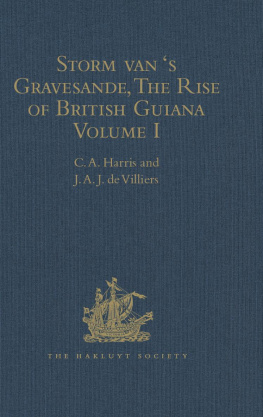

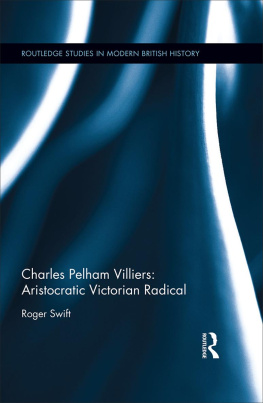


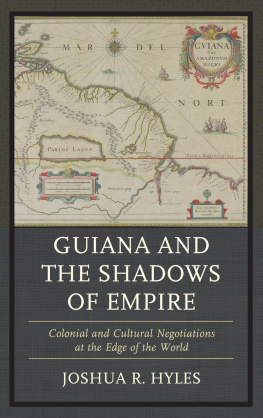
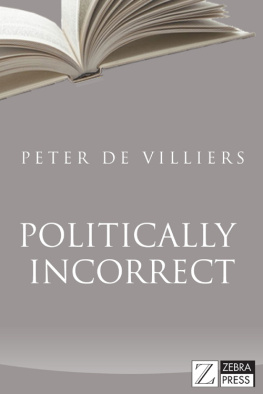
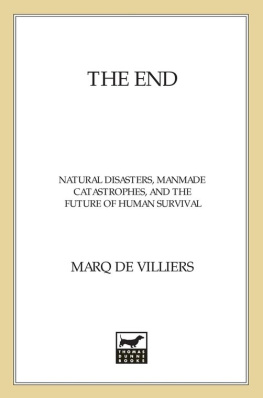






 RITISH GUIANAthe sole possession still held by Great Britain upon the Spanish Mainis divided into the three great counties of Demerara, Essequibo and Berbice, all colonies founded by the Dutch.
RITISH GUIANAthe sole possession still held by Great Britain upon the Spanish Mainis divided into the three great counties of Demerara, Essequibo and Berbice, all colonies founded by the Dutch.